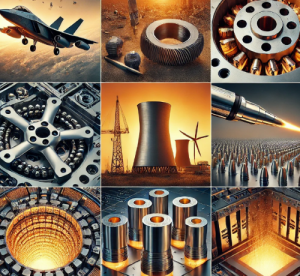Hafnium Carbonitride: An Ideal Material for Extreme Environments
Introduction
Hafnium carbonitride (HfCxNy) is an advanced ceramic material with extraordinary properties, making it a subject of interest for high-performance applications in extreme environments. This article will discuss its unique features, its synthesis methods and specific applications, particularly focusing on its use in aerospace engineering.

Exceptional Properties
Hafnium carbonitride (HfCN) is a compound that combines hafnium with carbon and nitrogen, known for its exceptional properties, including high hardness, high melting point, and excellent resistance to corrosion and wear.
- High Melting Point: Hafnium carbonitride has one of the highest melting points of any known material, exceeding 4000°C. This makes it ideal for applications requiring materials that can withstand extreme heat.
- Hardness: The material is extremely hard, comparable to other ultra-hard materials like tungsten carbide. This property makes it suitable for cutting tools and wear-resistant applications.
- Thermal Conductivity: Despite its high melting point, hafnium carbonitride exhibits good thermal conductivity, allowing it to efficiently dissipate heat.
- Chemical Stability: It is highly resistant to oxidation and corrosion, even at high temperatures, which is crucial for maintaining integrity in harsh environments.
Related reading: Tantalum Hafnium Carbide: Defying Extreme Conditions
Synthesis Methods
Hafnium carbonitride can be synthesized through several methods, each with specific advantages:
- Chemical Vapor Deposition (CVD): This process involves the reaction of hafnium tetrachloride (HfCl4), methane (CH4), and nitrogen (N2) gases at high temperatures. CVD allows precise control over the composition and properties of the resulting material.
- High-Temperature Solid-State Reactions: This method involves the direct reaction of hafnium, carbon, and nitrogen at high temperatures. It is simpler but may offer less control over the material’s microstructure.
- Carbothermal Reduction: This process uses carbon to reduce hafnium oxide (HfO2) in the presence of nitrogen. It is a cost-effective method for producing large quantities of hafnium carbonitride.
Applications in Extreme Environments
These properties above make it valuable in several advanced applications, particularly in high-performance and high-stress environments. Here are some key applications of hafnium carbonitride:
1. Aerospace Industry
– Thermal Protection Systems: HfCN is used in thermal protection systems for spacecraft and re-entry vehicles due to its high melting point and thermal stability.
– Aerospace Components: It is utilized in various aerospace components that require materials with high hardness and resistance to extreme temperatures.
2. Cutting Tools and Wear-Resistant Coatings
– Cutting Tools: Due to its exceptional hardness, HfCN is used to manufacture cutting tools for machining hard materials.
– Coatings: It is applied as a coating on various surfaces to enhance their wear resistance and lifespan.
3. Nuclear Industry
– Nuclear Fuel Cladding: HfCN is considered for use in nuclear reactors as a cladding material for nuclear fuel due to its high melting point and corrosion resistance, which are critical for withstanding the harsh environment inside a reactor.
4. High-Temperature Furnaces and Refractories
– Furnace Linings: It is used in high-temperature furnaces and reactors as a lining material to protect the structural components from extreme heat and chemical attack.
– Refractory Materials: HfCN is employed in the manufacture of refractory materials that must withstand very high temperatures and aggressive environments.
5. Electronics and Semiconductors
– Semiconductor Devices: It is used in the production of certain semiconductor devices where high thermal conductivity and stability are required.
– Thin Films: HfCN is used in thin film applications for electronic components, providing excellent electrical and thermal properties.
6. Biomedical Applications
– Biomedical Implants: Its biocompatibility and corrosion resistance make HfCN a candidate for use in biomedical implants and devices.
Cases in Aerospace Engineering
One of the most promising applications of hafnium carbonitride is in aerospace engineering, where materials are required to perform reliably under extreme conditions. A specific case study highlighting its application involves its use in the development of next-generation rocket nozzles.
–Background:
Rocket nozzles are subjected to extremely high temperatures and mechanical stresses during launch and re-entry. Traditional materials like graphite and tungsten, while effective, have limitations in terms of melting points and erosion resistance. Hafnium carbonitride, with its superior thermal and mechanical properties, presents a promising alternative.
–Development Process:
- Material Selection: Researchers selected hafnium carbonitride due to its high melting point and hardness.
- Synthesis: Using chemical vapor deposition, the material was synthesized with precise control over its composition to ensure optimal performance.
- Testing: The hafnium carbonitride nozzles were subjected to rigorous testing, including thermal cycling, mechanical stress tests, and exposure to oxidizing environments.
–Results:
The hafnium carbonitride nozzles demonstrated exceptional performance, withstanding temperatures exceeding 3500°C without significant degradation. The material maintained its structural integrity and showed minimal erosion compared to traditional materials. This successful application highlights the potential of hafnium carbonitride to enhance the durability and performance of critical aerospace components.
Conclusion
Hafnium carbonitride stands out as a high-performance material suitable for extreme environments. Its high melting point, hardness, thermal conductivity, and chemical stability open up numerous applications, particularly in aerospace engineering.
As research continues, the synthesis and application of hafnium carbonitride are expected to expand, offering innovative solutions to some of the most challenging material requirements in advanced engineering fields. For more materials with high melting points, please check Advanced Refractory Metals (ARM).



